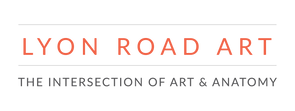Many have asked about my background in medical illustration. Not sure if you were just remotely interested, like maybe you were mingling with your grandma and Aunt Shelly over the holidays and there was a lull in the conversation and maybe you thought at that time, hmmm, you know what's weird but kinda cool? That thing Kaitlin does, with art and medicine combined. I'm going to ask Kaitlin to expand on that. Or maybe you're interested because you actually want to do a complete career 180 and embark on a med ill trajectory yourself. But honestly, the motivation in asking is irrelevant. I'm just excited to gush about my favorite topic.
I found out about medical illustration when I was incredibly frustrated in college at Marquette. I was pre-med but was missing art desperately, like a love-sick puppy dog. I was stalking art careers on the internet, and finally managed to google the magic words: "art and medicine career". Boom. A whole new field that I never realized existed emerged. I had found my soulmate.
I was thrilled to learn that there were four fantastic graduate programs in North America dedicated to this field. The actual degree names vary (mine was an MS in Biomedical Visualization from University of Illinois at Chicago), but the focus on medical art is essentially the same. I'll give you a fair warning, though: Getting in to the programs can be quite a challenge, due to both the number and variety of prerequisites, as well as the strength of portfolio required. But plan ahead, work hard, be open to critiques... you'll get there!
So once in, what did the program entail? This is the best part. It completely lived up to my very high expectations. (And waaay surpassed my expectations on difficulty. Currently shuddering in memory). We took med classes alongside med students, PT students and dentists. My favorite, hands-down, was the General Anatomy class, which included a cadaver lab. Yes, it was gross. And yes, it was enlightening and imperative to my artistic education and a highlight of my education. I just wish there was a little less fat juice that got on my shoes and that the smell of the lab didn't linger in my hair for so long. Ah well, the things we do for art.
We also, of course, took countless art classes. What made these better than any other art class I had taken was that they focused solely on the rendering of anatomy. So much of this I still use today. It was also a very tech-forward program, with a lot of emphasis on 3D drawing, animation and programming. Very career-relevant, given that so many medical illustration jobs today require these skills. (Honestly, I think I'm one in the minority by actually picking up paint and a brush every day!) Regardless, the takeaway is that the medical illustration field is growing in an exciting way. I feel lucky every day that I get to be a part of it.
So... are you in love yet? Do you want to do this too? If you're interested in more information, good. There is much to be had. A great resource is the Association of Medical Illustration. And I'd recommend following @sciartnow on instagram, they have great info. Now, just for funsies, here are images of a few grad school projects:
Abnormal Azygos Vein:

Carpal Tunnel:

3D Rendering of a Medical Instrument:

Knee Flexion and Extension:

Trabecular Meshwork:

A body outline drawing:

Bilateral Sagittal Split Osteotomy (BSSO):




